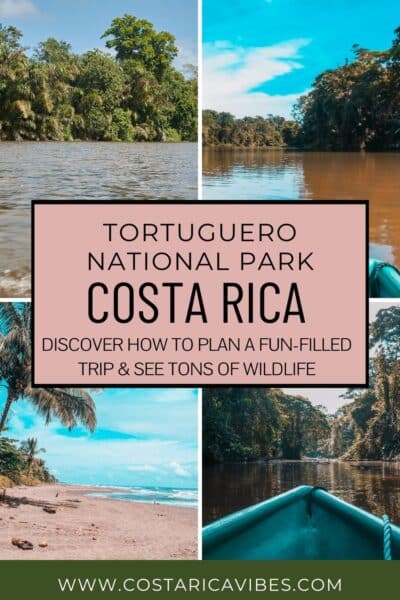Tortuguero National Park: Full Visitors Guide
Disclaimer: This article may contain affiliate links. Clicking on them may earn Costa Rica Vibes a commission, at no extra cost to you. Thank you for your support!
The Tortuguero National Park is located in the Costa Rican village of Tortuguero on the northern Caribbean coast. It is home to thousands of miles of protected waterways and land that can be accessed by canoe or kayak tours as well as by hiking. This area is also a protected area for green sea turtle nesting.
Continue reading for complete details on how to plan your visit!
Tortuguero National Park Background Info
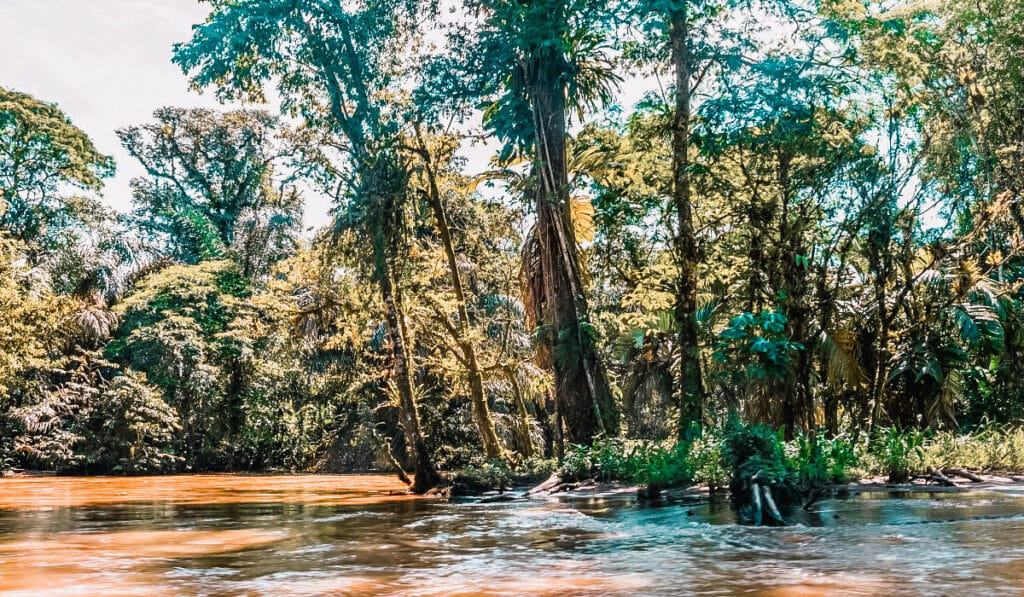
Starting in the 1920’s the main business in this area was turtle consumption. Turtles were used for their meat, eggs, and even their shells were used to make various wares.
This all changed in the early 1950’s when a zoologist named Dr. Archie Carr from the University of Florida in the United States came to Tortuguero to research the green sea turtles.
Dr. Carr was able to educate the people of Tortuguero on the importance of sea turtle conservation and helped to establish this area as a tourist destination. He convinced the locals that if they protected the turtles and led tours here they could make far more money and do something good for the environment.
The national park was founded in September 1970 and since then it has been modified three times to increase its area.
Personally, I find this all very interesting. If you would like to learn more about how Dr. Carr and subsequent researchers with the help of the local population were able to transform this area, I highly suggest visiting the Sea Turtle Conservancy Center while in Tortuguero.
Flora
The area is believed to be home to over 400 species of trees and over 2,000 species of other plants.
Fauna
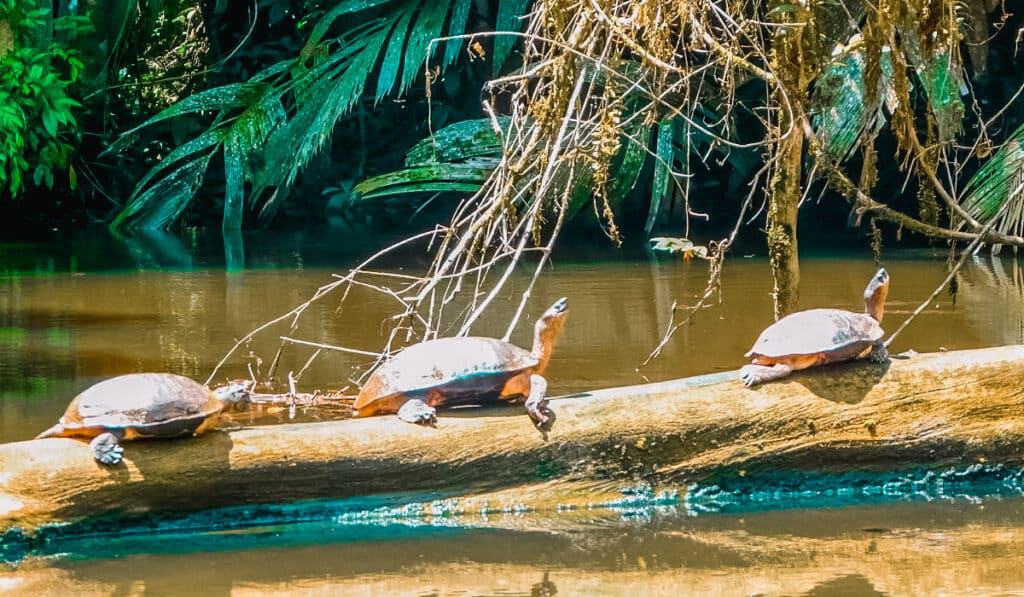
Some of the featured species that you may see here include; Green sea turtle, Green Macaw, Caiman, and Black turtles. If you are very lucky you may even spot a jaguar!
Geography
The park consists of over 77,000 acres of waterway and land. Of that, 99% is completely protected and only 1% is accessible to visitors.
Conservation
The area serves as protected nesting beaches for four species of sea turtles: Green, Leatherback, Hawksbill, and Big-headed.
Manatees also find protection here. They are one of the most threatened animals in Costa Rica so their conservation is really important.
The park also serves to protect the jaguar. Tortuguero has one of the largest populations in Costa Rica.
Tortuguero National Park Waterways Tour
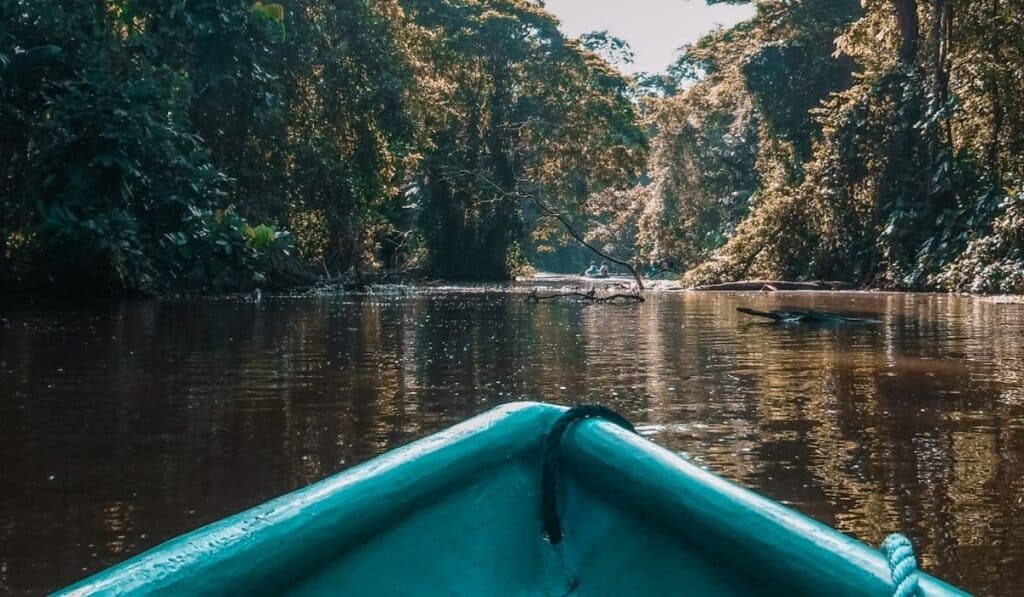
Taking a Tortuguero river tour is a must do activity in this area. It is the perfect way to see tons of flora and fauna with an experienced guide.
These tours usually start at 6:00am and last about two hours.
Yes, I know this is super early in the morning. But, this is when the wildlife is the most active. Plus, if you are a light sleeper like I am you will be up at 5:30 anyway when the birds start loudly chirping.
A waterway tour can be done by kayak or canoe. We usually opt for the canoe option if we want to take a lot of photos and the kayak option if we are more interested in enjoying the paddle.
Your tour will be conducted by an experienced local guide. These guides know where all the wildlife hang out (literally “hang out” because you’ll most likely see monkeys). Your guide will take you down several waterways and try to get as close as possible to unique flora and fauna so you can take a lot of pictures.
Some animals your guide may point out to you are river turtles, monkeys, freshwater fish, various species of birds, caimans, river otter, and egrets.
It is a really fun experience!
Booking Your Tour
Tortuguero doesn’t usually get overly full so it is always possible to book your tour last minute through the hotel you are staying at. However, if you would like some reassurance that your tour is set, you can pre-book below.
Keep in mind that most tours do not include the national park admission. You will need to purchase the admission yourself when you enter the park on the morning of your tour. The admission is valid for the entire day, so you can hike on the land portion of the park in the afternoon.
Our Favorite Tortuguero National Park Tours
There are three tours that we suggest. They are all slightly different, so let me explain each one to you.
Canoe Tour
This tour starts early in the morning (at 6am) from the Tortuguero National Park boat launch. A maximum of 8 people are allowed to be on each boat. Your guide will take you along the narrow waterways and point out plenty of wildlife.
We have done this tour twice and had a great time both times. The guides are really well informed and people of all ages will enjoy this.
Kayak Tour
If you would prefer to get out on a kayak and do all the paddling yourself, this tour is for you. Your guide will lead your small group in individual kayaks along the narrow waterways and through some small areas that the canoe riders can not get to. It’s fun!
2 in 1 Tour
We suggest this experience if you want the full Tortuguero National Park experience. This tour includes a wildlife canoe ride in the morning and a guided walking tour through the on-land portion of the park at 11:00am.
So, just as a reminder. No matter which boat tour you do, you will pay for park admission. So, you are welcome to visit the on-land portion of the park later in the day for no extra cost. This tour is more for those of you who would like a guide to point out on-land wildlife.
We haven’t done this tour, but I’ve heard good things about it. I think we will do it next time. Because, the walk through the on-land portion of the national park is nice, but not overly exciting. I think with a guide who actually knows where to spot wildlife it would be much more enjoyable.
Hiking in the Park
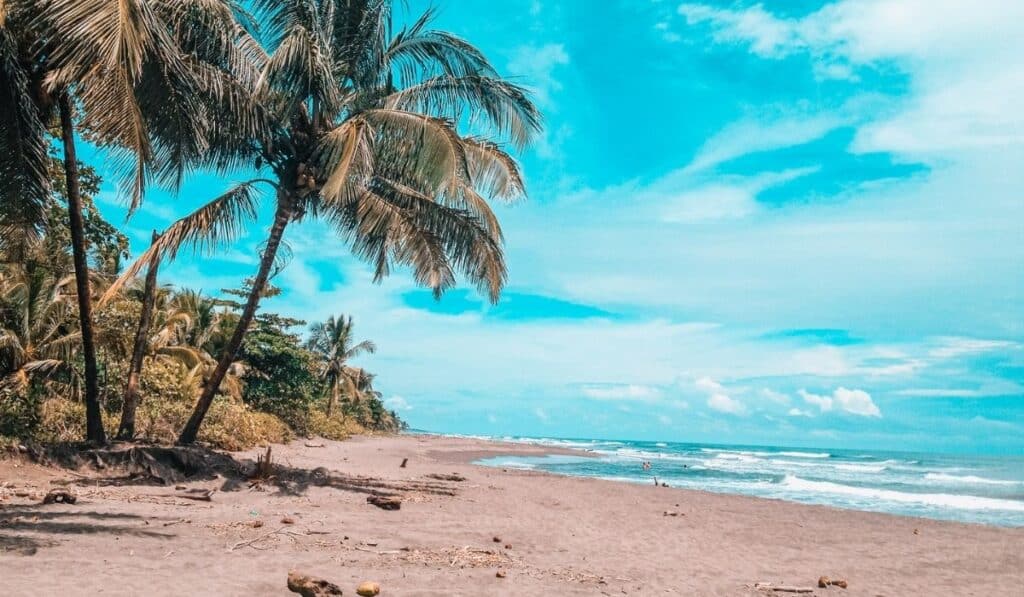
If you opt to do a canoe or kayak trip through the river waterways in the morning it is a good idea to hike in the national park in the afternoon.
As I stated above, you will need to purchase a national park ticket when you go on your morning ride, so it makes sense to do the hike on the same day and get the most out of the ticket you purchased.
Usually, we like to get breakfast after our canoe ride, take a short nap back at our hotel, and then hike through the park.
The hike is flat and manageable for almost all physical levels. The path is mostly well maintained but you might find a few roots sticking up here and there.
The path is technically a loop (or actually more like a square), but every time we have visited the second half of the trail has been closed due to extreme mud.
The first part of the trail is spent walking in from the park entrance in the direction of the beach. Keep in mind that this trail can get very muddy.
You will often see people renting rubber boots near the park entrance. If you are concerned about your footwear or there have been heavy rains recently, we strongly suggest renting a pair.
The second part of the trail runs parallel to the beach and has several small trails leading to the white sand beach.
Keep in mind that this is a turtle nesting beach, so please keep an eye out on where you step. Occasionally you might spot little baby turtles hatching and making their first journey to the water.
From here, the trail loops back to the beginning (if it is not closed due to mud). In total, you can expect to spend about three hours walking and checking out the beach area.
Evening Turtle Tour
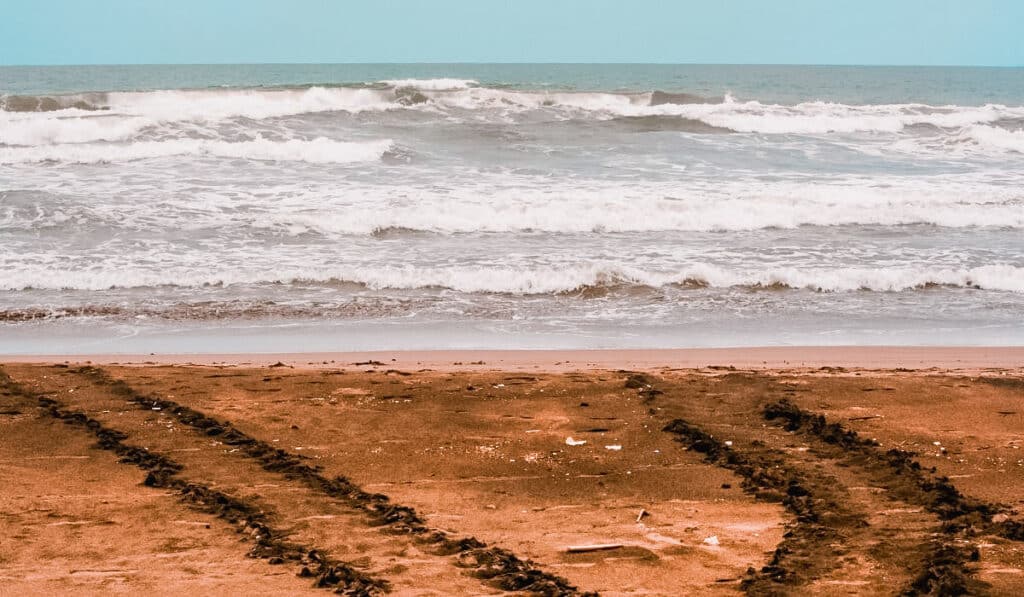
If you visit Tortuguero during peak green sea turtle nesting time (July to late September), we definitely suggest taking an evening turtle tour. These tours depart after sunset and are spent on the beach with an experienced guide.
During your tour, your guide will tell you about the history of turtle conservation in Tortuguero and tell you plenty of fun facts about turtles.
Hopefully, you will have the chance to see a few big mom turtles making their way from the ocean up the beach before they dig a hole to deposit their eggs.
Keep in mind that you are not allowed to take pictures or get too close to the turtles. Also, wear comfortable footwear because it will be very dark. Your guide will have a red light flashlight (this doesn’t disturb the turtles) but all other lights are not allowed.
It is usually possible to book your tour at your hotel, but during peak season the tours can book out. If you would like to pre-book, you can do that below.
Practical Information for Tortuguero National Park
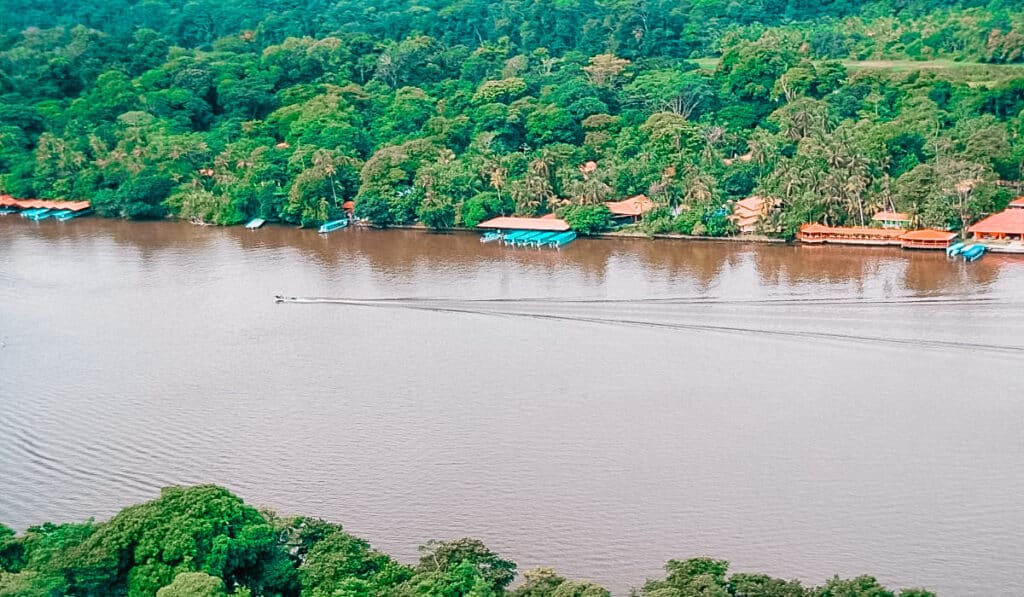
Park Hours
The park is open daily from 6:00am until 4:00pm
Cost
Costa Rica Nationals and resident adults: ¢1.000
Costa Rica National and resident children: ¢500
Foreign non-resident adults: $15
Foreign non-resident children: $5
Dollars, colones, and credit cards are accepted forms of payment
Facilities
Next to the ranger station, there is a bathroom, drinking water (but we suggest drinking bottled water here), and an info kiosk.
What to Bring
For the canoe or kayak ride we suggest; a bottle of water, your phone or camera, a waterproof case for your phone or camera (just in case).
For the hike we suggest; at least one bottle of water, a snack, sunscreen, bug spray, your camera, pocket binoculars for spotting wildlife.
What to Wear
For the canoe ride, I suggest wearing a long sleeve shirt over a t-shirt. It can be cool in the morning but warms up fast.
It’s nice to have layers because the sun can be really strong while you are out in the canoe.
If I feel like I’m getting burned I like to have a long sleeve shirt to throw on top.
We usually opt for sports shorts and flip-flops. You won’t likely get wet, but you never know.
Also, wear a hat to protect you from the sun.
For the hike, we suggest having some kind of footwear you do not mind getting wet (like Keen’s). At the beginning of the trail, there is sometimes a lot of mud if there have been heavy rains recently.
We suggest wearing some kind of sports shorts, a t-shirt, and a sun-blocking hat.
Don’t forget your swimsuit if you plan on cooling off in the ocean after!
Directions
You first need to get to Tortuguero. This is always a bit of an adventure because the village is only accessible by boat from the village of La Pavona on the mainland.
You can read our complete guide to Tortuguero for more info.
Once you are in Tortuguero, just walk to the most southern part of Tortuguero along the main road through the village and you will come to the entrance point of the national park.
↪FIND OUT HOW TO GET UP TO 10% OFF YOUR CAR RENTAL IN COSTA RICA!
Best Time of Year to Visit
The prime to visit this area is between July and late September. This is when the weather will be dry and hot.
It is also a great time to visit because it is the time of year when the green sea turtles lay their eggs.
Where to Stay Nearby
Tips for Visiting
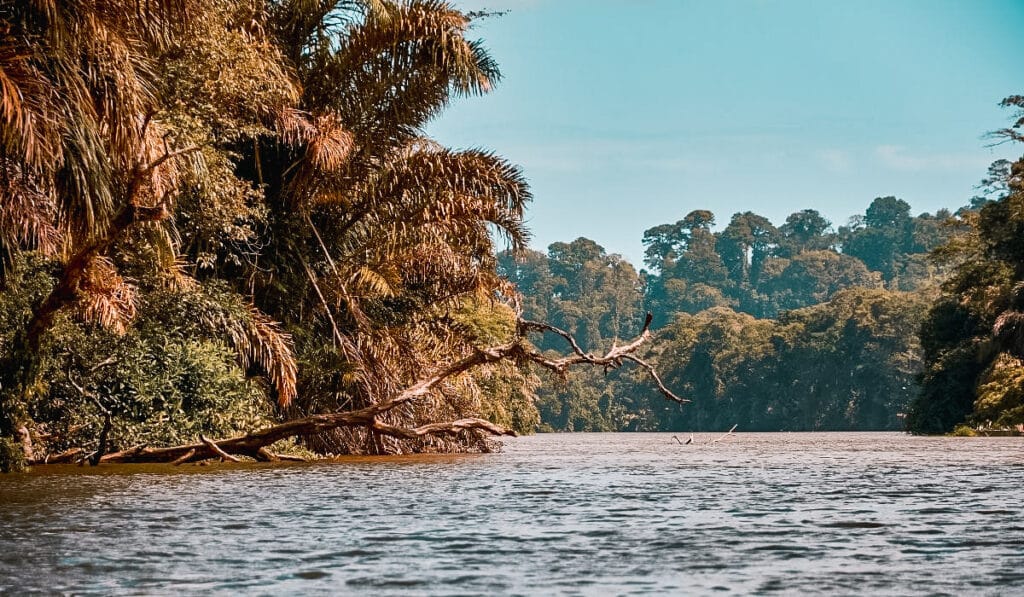
– You are not allowed on the beach after 6 pm (when the green sea turtles come to lay their eggs) without a guide and before 6 am.
– Don’t forget to check out our Tortuguero Destination Guide for all the tips on the best hotels, great restaurants. transportation info, and more!
– You should not swim in the river. Locals do, but there are caimans (small crocodiles). I wouldn’t mess with them.
– Keep in mind that the beach is a protected area. Please don’t leave any trash and look out when walking. You don’t want to accidentally step on turtle eggs or a little baby making its way into the ocean.
– We always like to bring a small trash bag and pick up any trash we find during our walk. It is a nice way to help keep the area clear and safe for the turtles.
– If you love turtles and would like to participate in turtle research in Tortuguero, check out the Sea Turtle Conservancy website. Here you can find info about internships and research programs.
What to Do After

Visit the Sea Turtle Conservancy Center
There is a small Sea Turtle Conservancy Visitors Center located in Tortuguero. I strongly suggest visiting.
It is really interesting to read all about the change that the village went through from a place that poached the sea turtle eggs to a village that prides itself in conservation. You can also learn all about the green turtles and their life cycles.
Relax on the Beach
The beaches in Tortuguero are not the nicest in the country, but it is still a nice spot to lounge in the sun and enjoy the lapping water. You can also walk for miles if that is more your speed.
Spend the Afternoon Lounging at Budda Cafe
Budda Cafe is our favorite restaurant in Tortuguero. Most of the tables are set up on the dock with a nice view of the river. It is a great place to get a few cocktails and enjoy some excellent food.
FAQ: Tortuguero National Park
How do you get to Tortuguero National Park?
The park is accessible only by boat or small plane.
By Boat: From the town of La Pavona, a motorized boat navigates through the system of rivers to Tortuguero.
By Air: You can opt to fly to Tortuguero’s airstrip.
How much is the park fee in Tortuguero?
The park entrance is $15 for adults and $5 for children. You will need to pay extra for a canoe or kayak wildlife tour within the park.
Where is Tortuguero National Park?
Tortuguero National Park is located on the northern Caribbean coast of Costa Rica near the Nicaragua border. It is only accessible by boat or plane.
What is there to do in Tortuguero National Park?
The most popular activity in the national park is to take an early morning canoe or kayak wildlife tour through the waterways. It is possible to hike on trails in the park and along the beach.
Wrap Up to Tortuguero National Park
Overall, Tortuguero National Park is a unique experience that we highly recommend you visit. In my opinion, it is a Costa Rica highlight that feels like entering a completely other world. Plus, who can pass up the chance to possibly see sea turtles?
Do you still have some questions about planning your visit to Tortuguero National Park? Leave them in the comment section below and we will help you out as best as we can!
You Might Also Like:
Costa Rica Travel Details: What You Need to Know
🚗 Should I rent a car in Costa Rica?
Having a rental car will give you the most flexibility when traveling in Costa Rica. This will also allow you to take fun day trips on your own.
- Save 10% Plus Other Perks with Our Adobe Rental Car Discount
- You might also consider; shared shuttle services or private transfer services
🏄🏽 How can I book things to do?
We find that Viator tends to have the most comprehensive selection of activities with secure booking and good cancellation policies.
🍍 I’m overwhelmed with planning. Can you help?
Of course! I suggest joining our Facebook group for specific questions and head to our Start Here Page to get started planning.
✈️ What is the best way to book a flight?
Usually, we have the best luck finding great prices with Skyscanner. Check for flights to both San Jose Airport (SJO) and Liberia Airport (LIR).
🛏️ What is the best way to book my Costa Rica hotels?
We highly suggest Booking.com for hotel bookings and typically use VRBO for Costa Rica vacation rentals.
🗣️What is the main language in Costa Rica?
The main language in Costa Rica is Spanish. Most people working in tourism speak at least some English.
💰 What is the currency in Costa Rica?
The currency used in Costa Rica is the Costa Rican colón (CRC). However, the US dollar is widely accepted in most tourist areas
📞 What is the best way to stay connected?
An eSIM from Airalo is the easiest way to get 4G data while traveling in Costa Rica.
🌴 Is Costa Rica safe?
Generally, Costa Rica is considered safe for tourists. However, like any travel destination, it’s best to use caution and be aware of your surroundings.
🛂 Do you need a passport to go to Costa Rica?
Yes, Costa Rica is its own country. You will need a passport to visit.

Hi! We’re Thomas (the German) and Sarah (the US-er)
We met in Virginia, moved to Germany, and since 2016 we have lived in sunny Costa Rica.
It was a spontaneous decision to move here, but it was the best decision!
Now we spend our days roaming the country to bring you the very best in Costa Rica travel here on Costa Rica Vibes.
Sarah is the writer. Thomas is the one keeping it all together.
Want the whole crazy story?

Sarah McArthur
Sarah McArthur is the co-founder and main writer of Costa Rica Vibes.
She is originally from the United States but has lived in sunny San Jose, Costa Rica since 2016.
She has traveled all over the country and now considers herself a self-proclaimed Costa Rica travel expert.
Want the whole crazy story?

